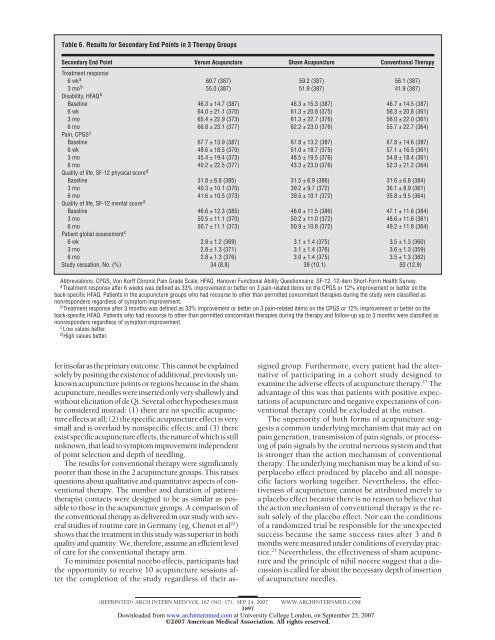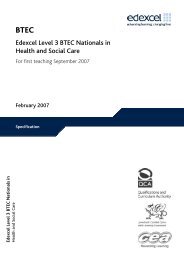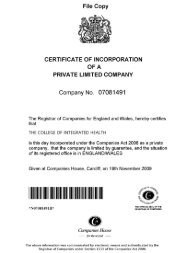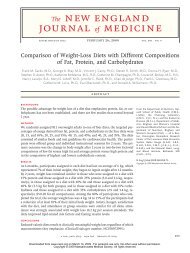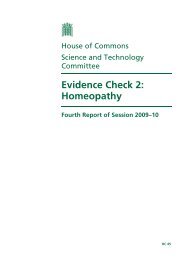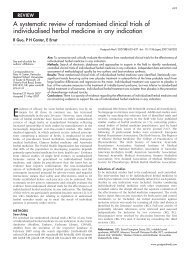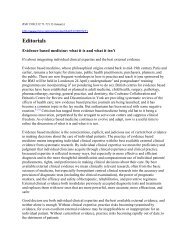German Acupuncture Trials (GERAC) for Chronic Low Back Pain
German Acupuncture Trials (GERAC) for Chronic Low Back Pain
German Acupuncture Trials (GERAC) for Chronic Low Back Pain
Create successful ePaper yourself
Turn your PDF publications into a flip-book with our unique Google optimized e-Paper software.
Table 6. Results <strong>for</strong> Secondary End Points in 3 Therapy Groups<br />
Secondary End Point<br />
Treatment response<br />
Verum <strong>Acupuncture</strong> Sham <strong>Acupuncture</strong> Conventional Therapy<br />
6wka 60.7 (387) 59.2 (387) 56.1 (387)<br />
3mob Disability, HFAQ<br />
55.0 (387) 51.9 (387) 41.9 (387)<br />
b<br />
Baseline 46.3 ± 14.7 (387) 46.3 ± 15.3 (387) 46.7 ± 14.5 (387)<br />
6 wk 64.0 ± 21.1 (370) 61.3 ± 20.8 (375) 56.3 ± 20.8 (361)<br />
3 mo 65.4 ± 22.9 (373) 61.3 ± 22.7 (376) 56.0 ± 22.0 (361)<br />
6 mo<br />
<strong>Pain</strong>, CPGS<br />
66.8 ± 23.1 (377) 62.2 ± 23.0 (376) 55.7 ± 22.7 (364)<br />
c<br />
Baseline 67.7 ± 13.9 (387) 67.8 ± 13.2 (387) 67.8 ± 14.6 (387)<br />
6 wk 48.6 ± 18.5 (370) 51.0 ± 18.7 (375) 57.1 ± 16.5 (361)<br />
3 mo 45.4 ± 19.4 (373) 48.5 ± 19.5 (376) 54.8 ± 18.4 (361)<br />
6 mo<br />
Quality of life, SF-12 physical score<br />
40.2 ± 22.5 (377) 43.3 ± 23.0 (376) 52.3 ± 21.2 (364)<br />
d<br />
Baseline 31.8 ± 6.8 (385) 31.5 ± 6.9 (386) 31.6 ± 6.8 (384)<br />
3 mo 40.3 ± 10.1 (370) 39.2 ± 9.7 (372) 36.1 ± 8.9 (361)<br />
6 mo<br />
Quality of life, SF-12 mental score<br />
41.6 ± 10.5 (373) 39.5 ± 10.1 (372) 35.8 ± 9.5 (364)<br />
d<br />
Baseline 46.6 ± 12.3 (385) 46.6 ± 11.5 (386) 47.1 ± 11.6 (384)<br />
3 mo 50.5 ± 11.1 (370) 50.2 ± 11.0 (372) 48.6 ± 11.6 (361)<br />
6 mo<br />
Patient global assessment<br />
50.7 ± 11.1 (373) 50.9 ± 10.8 (372) 49.2 ± 11.8 (364)<br />
c<br />
6 wk 2.8 ± 1.2 (369) 3.1 ± 1.4 (375) 3.5 ± 1.3 (360)<br />
3 mo 2.8 ± 1.3 (371) 3.1 ± 1.4 (376) 3.6 ± 1.3 (359)<br />
6 mo 2.8 ± 1.3 (376) 3.0 ± 1.4 (375) 3.5 ± 1.3 (362)<br />
Study cessation, No. (%) 34 (8.8) 39 (10.1) 50 (12.9)<br />
Abbreviations: CPGS, Von Korff <strong>Chronic</strong> <strong>Pain</strong> Grade Scale; HFAQ, Hanover Functional Ability Questionnaire; SF-12, 12-item Short-Form Health Survey.<br />
a Treatment response after 6 weeks was defined as 33% improvement or better on 3 pain-related items on the CPGS or 12% improvement or better on the<br />
back-specific HFAQ. Patients in the acupuncture groups who had recourse to other than permitted concomitant therapies during the study were classified as<br />
nonresponders regardless of symptom improvement.<br />
b Treatment response after 3 months was defined as 33% improvement or better on 3 pain-related items on the CPGS or 12% improvement or better on the<br />
back-specific HFAQ. Patients who had recourse to other than permitted concomitant therapies during the therapy and follow-up up to 3 months were classified as<br />
nonresponders regardless of symptom improvement.<br />
c <strong>Low</strong> values better.<br />
d High values better.<br />
ferinsofarastheprimaryoutcome.Thiscannotbeexplained<br />
solelybypositingtheexistenceofadditional,previouslyunknown<br />
acupuncture points or regions because in the sham<br />
acupuncture, needles were inserted only very shallowly and<br />
without elicitation of de Qi. Several other hypotheses must<br />
be considered instead: (1) there are no specific acupuncture<br />
effects at all; (2) the specific acupuncture effect is very<br />
small and is overlaid by nonspecific effects; and (3) there<br />
exist specific acupuncture effects, the nature of which is still<br />
unknown,thatleadtosymptomimprovementindependent<br />
of point selection and depth of needling.<br />
The results <strong>for</strong> conventional therapy were significantly<br />
poorer than those in the 2 acupuncture groups. This raises<br />
questions about qualitative and quantitative aspects of conventional<br />
therapy. The number and duration of patienttherapist<br />
contacts were designed to be as similar as possible<br />
to those in the acupuncture groups. A comparison of<br />
the conventional therapy as delivered in our study with several<br />
studies of routine care in <strong>German</strong>y (eg, Chenot et al 22 )<br />
shows that the treatment in this study was superior in both<br />
quality and quantity. We, there<strong>for</strong>e, assume an efficient level<br />
of care <strong>for</strong> the conventional therapy arm.<br />
To minimize potential nocebo effects, participants had<br />
the opportunity to receive 10 acupuncture sessions after<br />
the completion of the study regardless of their as-<br />
signed group. Furthermore, every patient had the alternative<br />
of participating in a cohort study designed to<br />
examine the adverse effects of acupuncture therapy. 17 The<br />
advantage of this was that patients with positive expectations<br />
of acupuncture and negative expectations of conventional<br />
therapy could be excluded at the outset.<br />
The superiority of both <strong>for</strong>ms of acupuncture suggests<br />
a common underlying mechanism that may act on<br />
pain generation, transmission of pain signals, or processing<br />
of pain signals by the central nervous system and that<br />
is stronger than the action mechanism of conventional<br />
therapy. The underlying mechanism may be a kind of superplacebo<br />
effect produced by placebo and all nonspecific<br />
factors working together. Nevertheless, the effectiveness<br />
of acupuncture cannot be attributed merely to<br />
a placebo effect because there is no reason to believe that<br />
the action mechanism of conventional therapy is the result<br />
solely of the placebo effect. Nor can the conditions<br />
of a randomized trial be responsible <strong>for</strong> the unexpected<br />
success because the same success rates after 3 and 6<br />
months were measured under conditions of everyday practice.<br />
23 Nevertheless, the effectiveness of sham acupuncture<br />
and the principle of nihil nocere suggest that a discussion<br />
is called <strong>for</strong> about the necessary depth of insertion<br />
of acupuncture needles.<br />
(REPRINTED) ARCH INTERN MED/ VOL 167 (NO. 17), SEP 24, 2007 WWW.ARCHINTERNMED.COM<br />
1897<br />
Downloaded from<br />
www.archinternmed.com at University College London, on September 25, 2007<br />
©2007 American Medical Association. All rights reserved.


